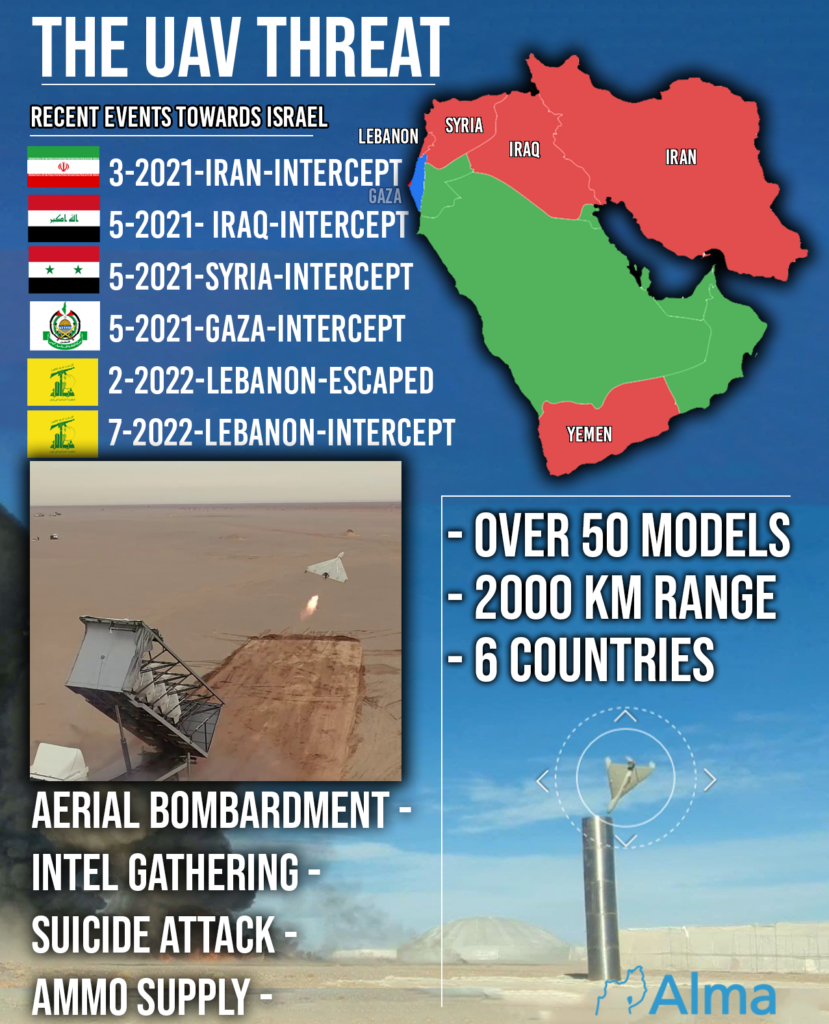In the image: Hezballah’s aerial unit insignia.
Hezbollah acts only in its own interests. While the Lebanese government was negotiating the maritime border with Israel, Hezbollah deployed yesterday (July 2nd) three (apparently unarmed) UAVs to the “Karish” gas rig. In our estimation, Hezbollah’s goal is to send a message following Nasrallah’s militant speech on June 9th in which he compared the maritime border issue’s importance to that of the “liberation” of southern Lebanon in 2000. This is Hezbollah’s way of getting out of the corner Nasrallah backed himself into with his speech. Deploying the three UAVs is Nasrallah’s way of satisfying Hezbollah’s Shiite base. Another possible message Hezbollah is sending is that if Israel will begin harvesting natural gas from the “Karish” gas rig in September, the next UAVs Hezbollah will deploy will be armed.
Hezbollah took responsibility for the deployment of “three unarmed UAVs of various sizes…”, as it has stated. Hezbollah’s Aerial Unit is responsible for operating Hezbollah’s UAVs. Hezbollah’s act was made in memory of two of its Aerial Unit operatives that were killed in 1994 (Jamil Sakaf) and in 2013 (Mahdi Ya’i).
UAV models in Hezbollah’s service
“Ayub” – based on the Iranian “Shahed 129. Apparently, this is a model that was “inspired” by the Israeli “Hermes 450” model that fell in Beirut during the Second Lebanon War in the summer of 2006.
We have documentation (the photos on the right and center) of a similar UAV intercepted near the southern Syrian city of Deraa in 2016, which was sent on an intelligence-gathering mission near the Jordanian border. This UAV is very similar to the “Ayub,” which was publicly presented by Hezbollah (on the left).



“Mirsad 1” – In Hezbollah’s service since 2002. Based on some of our sources, this UAV is based on the Iranian “Mohajer 2”, except for a few external differences. Other sources in our possession claim this UAV originates from the Ababeel model.

“Mirsad 2” – In Hezbollah’s service since 2003. Based on the Iranian “Mohajer 4” model.

Ababeel” – During the Second Lebanon War (August 2006), the IDF shot down a UAV (in the bellow photo on the left), which is defined as an “Ababeel” (the UAV was not carrying any explosives). The UAV shot down is probably a version of the “Ababeel T” (in the bellow photo on the right), which bears a striking resemblance to the “Mirsad.”


“Ma’arab” is the Iranian “Yasser” model – It was used in Syria by Hezbollah.

“Rami 1” – a replica of the Iranian UAV “Ra’ad 1.”
We estimate that Hezbollah most likely has additional advanced UAV models, such as the “Mohajer,” “Shahed,” and “Samed” (KAS-04), “Karrar,” and “Saegheh” types. As we noted, in Hezbollah’s arsenal about 2000 UAVs in total.
In addition, Hezbollah (as well as Hamas and Islamic Jihad in the Gaza Strip) possess and use dozens of drones, mostly Chinese-made, that can be purchased in the civilian market. Hezbollah adapts these drones to its needs, both for photography and carrying and dropping bombs.
These drones’ flight range (up to a few kilometers) and flight time (a few minutes) are limited. However, these are small and low-noise devices, features that make them difficult to detect. Some drones are equipped with a system that allows them to be launched by entering coordinates in advance to carry out their mission in a pre-entered geographical trajectory and automatically returning them to their launch site. This reduces the exposure potential of the force launching the drone since the launching party does not need to stay static during the execution of the mission, only during the launching.

“Public appearances” of UAVs and drones used by Hezbollah
- November 2004: Hezbollah succeeds in sending a “Mirsad” UAV, which wanders the northern Israeli skies for 18 minutes, returning to its base safely. A similar incident occurred in April 2005.
- July-August 2006: During the Second Lebanon War, Hezbollah made a few attempts to send UAVs into Israeli territory. All the attempts were intercepted, including the afore-mentioned “Ababeel T.”
- October 2012: Hezbollah launches a UAV via the Mediterranean Sea, which reaches the Negev region of Israel and is intercepted by warplanes.

- April 2013: Hezbollah launches a UAV that is intercepted near Haifa Bay.
- January 2014: Hezbollah launches a UAV over Samir Geagea’s house, apparently for intimidation. Hezbollah defines Samir Geagea as public enemy number one in the internal Lebanese arena. We estimate that Samir Gahgah is still under close Hezbollah intelligence surveillance.
- May 2015: Hezbollah attacks in the al-Qalamoun area in Syria with a UAV capable of firing precision-launched missiles. (The act is documented and published in “al-Manar,” the Lebanese satellite television station).
- August 2016: A video of Hezbollah drones attacking Aleppo shows Chinese MZD2 bombs dropped from cheap Chinese drones that can be bought for $600.

- August 2017: An unknown UAV attacks in al-Qalamoun Syria, dropping inaccurate explosive devices in free fall. Hezbollah’s combat media released the attack images:

- October 2019 – Hezbollah claimed that a Hezbollah reconnaissance and intelligence UAV managed to fly over the Galilee area in Israeli territory during an IDF exercise.
- February 2022 – Hezbollah took responsibility for a reconnaissance and intelligence UAV that penetrated Israeli air space to Rosh Pina and the Kinerret area. The UAV managed to evade interception and returned to Lebanon.
- July 2022 – Hezbollah took responsibility for launching “three unarmed UAVs of various sizes…” as they put it, towards the Karish gas fields in the Israeli economic exclusion zone. The responsibility of Hezbollah for operating the UAV is that of their air unit. The operation was named after two Hezbollah operatives killed in 1994 (Jamil Sakaf) and in 2013 (Mahdi Yari) who may have belonged to the air unit.
For our full report on “The Iranian UAV Army”, click here https://israel-alma.org/2021/12/21/irans-uav-army-a-global-threat/






